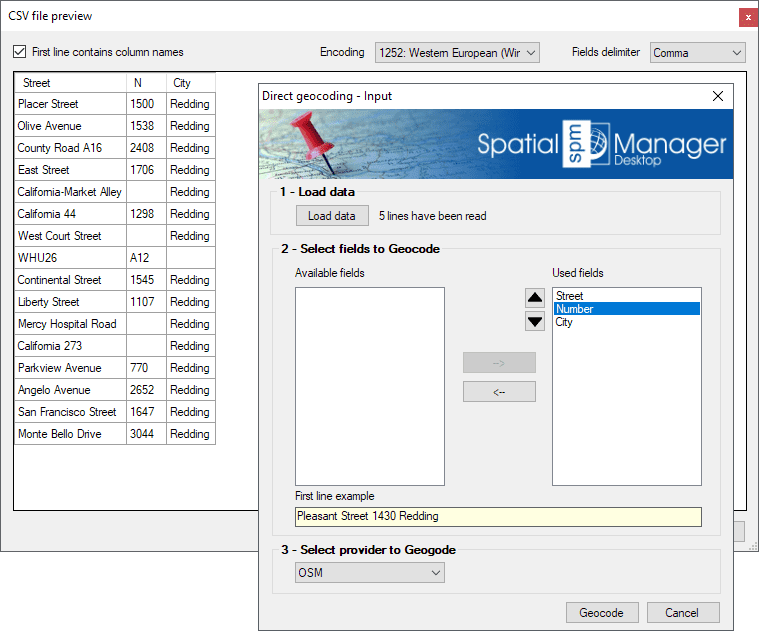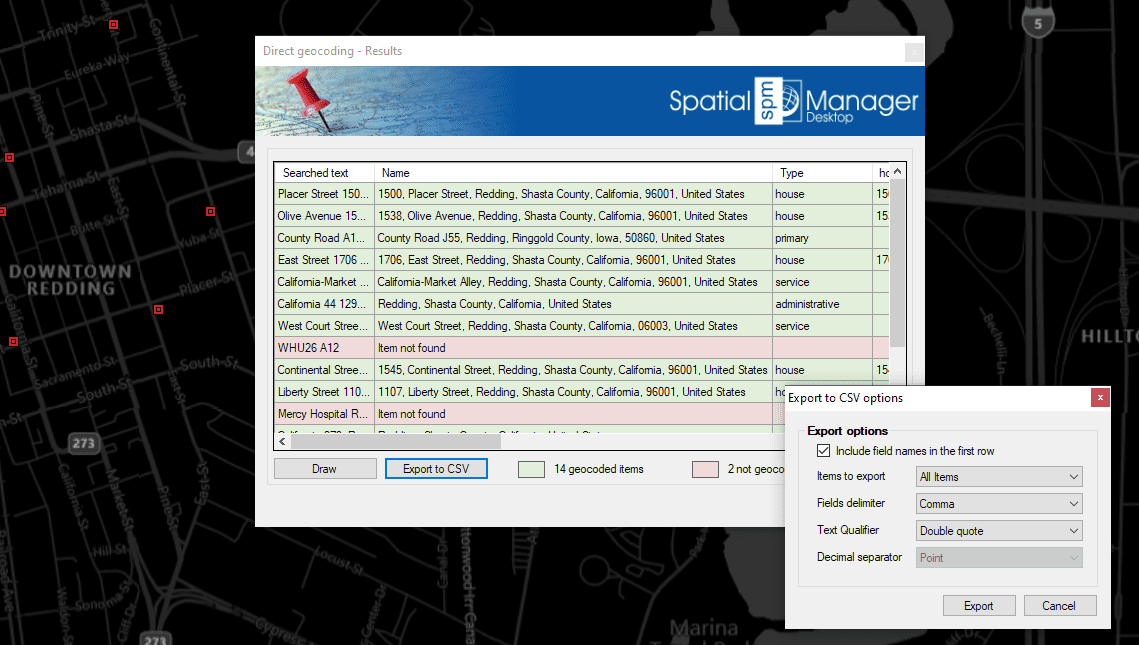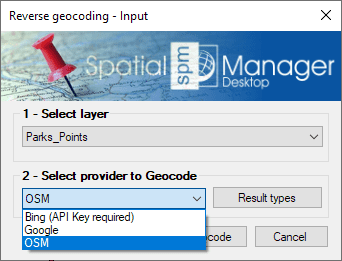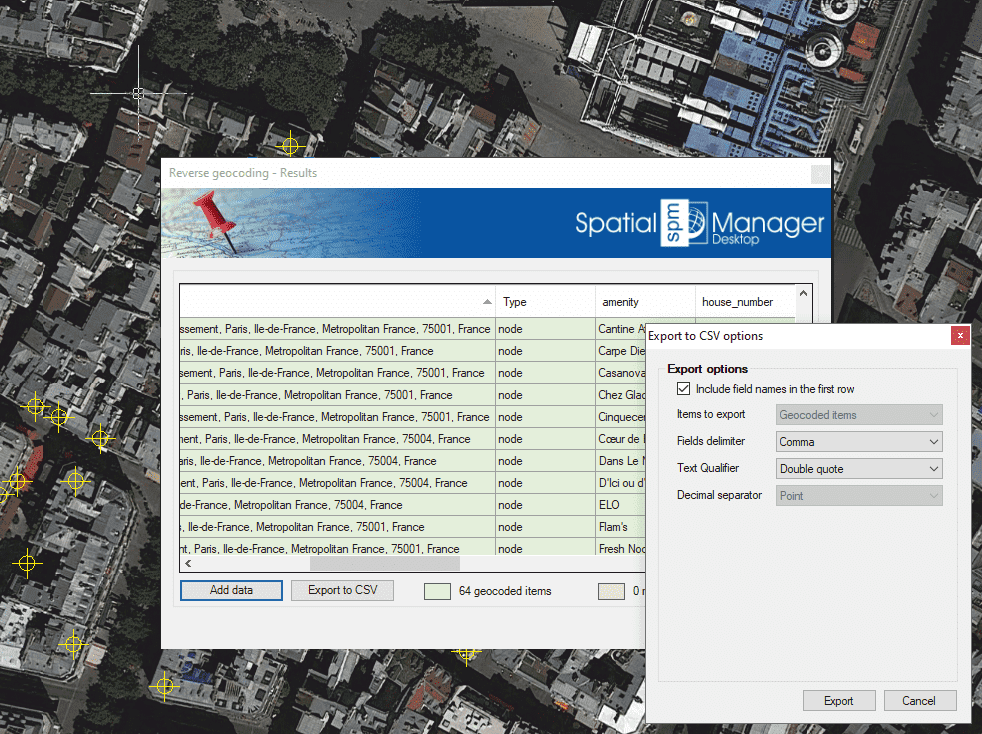Difference between revisions of "Spatial Manager Desktop™ - FAQs: Geo-Coding ("Professional" edition only)"
m |
m |
||
| Line 44: | Line 44: | ||
Once the direct Geocoding process is finished, you will get a results table including all the fields returned by the chosen geocoding service. Those addresses that could not be geocoded (May be due to insufficient or inconclusive data) are shown in a different color). From the results of the table, you can: | Once the direct Geocoding process is finished, you will get a results table including all the fields returned by the chosen geocoding service. Those addresses that could not be geocoded (May be due to insufficient or inconclusive data) are shown in a different color). From the results of the table, you can: | ||
| − | *''Draw the geocoded Points''. Note that you can use the 'Direct geocoding' function even without any map document open. In this case, the insertion of Points will be processed in a new document | + | *''Draw the geocoded Points''. Note that you can use the 'Direct geocoding' function even without any map document open. In this case, the insertion of Points will be processed in a new blank document |
*''Export the table to a CSV file'': Select the exporting to CSV parameters (Delimiter, separator, etc.). You can also opt to omit in the exported CSV the addresses that have not been geocoded | *''Export the table to a CSV file'': Select the exporting to CSV parameters (Delimiter, separator, etc.). You can also opt to omit in the exported CSV the addresses that have not been geocoded | ||
Latest revision as of 09:19, 7 July 2022
Notes:
- Some components in the images on this page (providers, names, windows look, etc.) may be slightly different from those that will appear on your computer
- Some application functions need to access the Internet from the application itself. If you experiment problems in any process, ask your network administrator if there is a Proxy server installed on your network. You can configure the Proxy settings through the application options
- Some geographic data providers (Geocode, image Maps, etc.) may need a user account, which you can configure in the Service Provider API Keys settings through the application options
Introduction
- Objective of this section
- To learn how to create points in the maps from a postal addresses list (Direct Geocoding)
- To learn how to collect a postal addresses list from map features (Reverse Geocoding)
- Topics in this section
- Direct Geocoding
- Select the addresses file, fields, fields order and the Geocode provider
- Draw the geocoded points
- Export the geocoded results to a CSV file
- Reverse Geocoding
- Select the Layer for collecting postal addresses and the Geocode provider
- Add postal addresses data to the table
- Export the geocoded results to a CSV file
- Direct Geocoding
How can I insert map Points from a geographic data table?
Spatial Manager Desktop™ includes the 'Direct geocoding' function that allows you to compose addresses from a geographic data file (CSV, TXT, etc.) and geocoding these addresses through a Geocode provider (Google, Bing, OpenStreetMap). Once you load the geographic file, you can preview the resulting table, configure some file parameters (such as the Fields delimiter, etc.), select (add or remove) and sort the appropriate fields, and select the provider to Geocode from the list


Notes:
- Certain location service providers (such as Google or Bing) may require special terms of use for the users of this service. You can configure any special setting for such providers through the "Service Provider API Keys" in the application Options ('SPMOPTIONS')
- If you select a large number of addresses to Geocode, the application will warn you that this operation may involve a high data consumption depending on the Geocoding provider chosen
Once the direct Geocoding process is finished, you will get a results table including all the fields returned by the chosen geocoding service. Those addresses that could not be geocoded (May be due to insufficient or inconclusive data) are shown in a different color). From the results of the table, you can:
- Draw the geocoded Points. Note that you can use the 'Direct geocoding' function even without any map document open. In this case, the insertion of Points will be processed in a new blank document
- Export the table to a CSV file: Select the exporting to CSV parameters (Delimiter, separator, etc.). You can also opt to omit in the exported CSV the addresses that have not been geocoded

How can I get the postal addresses of features in the map?
Spatial Manager Desktop™ includes the 'Reverse geocoding' function that allows you to obtain the postal addresses of the features in a map Layer through a Geocode provider (Google, Bing, OpenStreetMap). All that you need is to select the map Layer to be geocoded, choose the provider to Geocode from the list and, optionally, choose the result types (Which depend on the results returned by each provider)


Notes:
- Certain location service providers (such as Google or Bing) may require special terms of use for the users of this service. You can configure any special setting for such providers through the "Service Provider API Keys" in the application Options ('SPMOPTIONS')
- If you select a large number of features to Geocode, the application will warn you that this operation may involve a high data consumption depending on the Geocoding provider chosen
- Note that if you select non-point features to Geocode (such as Polygons, Polylines, etc.) the results may be inaccurate depending on the shapes of these features. For example, for polygonal features (such as Parcels, Zones, etc.) the centroid of the features will be chosen to calculate their postal address, which may be inaccurate if the shape of these polygons causes the centroid to be outside the polygon or away from the appropriate postal address
Once the reverse Geocoding process is finished, you will get a results table including all the fields returned by the chosen geocoding service. Those addresses that could not be geocoded (May be due to insufficient or inconclusive data) are shown in a different color). From the results of the table, you can:
- Add data: To add the geocoding data to other existing features data
- Export the table to a CSV file: Select the exporting to CSV parameters (Delimiter, separator, etc.). You can also opt to omit in the exported CSV the addresses that have not been geocoded

See also the 'Search for Locations' chapter
Related links
- Blog posts